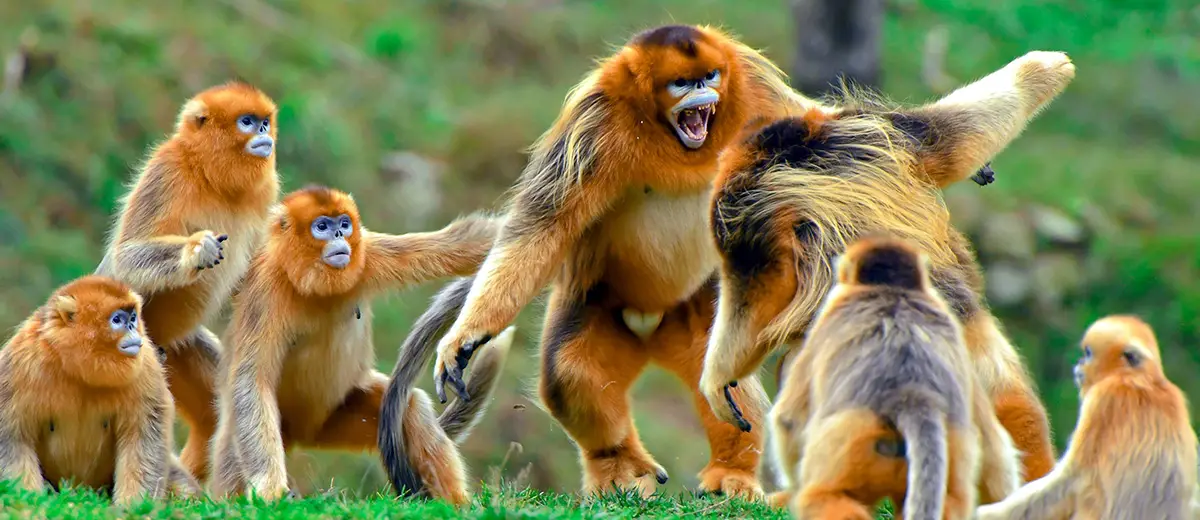13 Most Spectacular Asian Monkey Species
If there is one thing Asian monkeys can boast about, it’s how stylish they are. From the spectacular natal coats of the langur group to the fabulous hairstyles of others, when it comes to interesting pelage, there are few animals that compete with Asian primates. The species included in this list are not only visually impressive but also located in some of the world’s most incredible locations including the island nation of Japan and the foothills of the Himalayas.
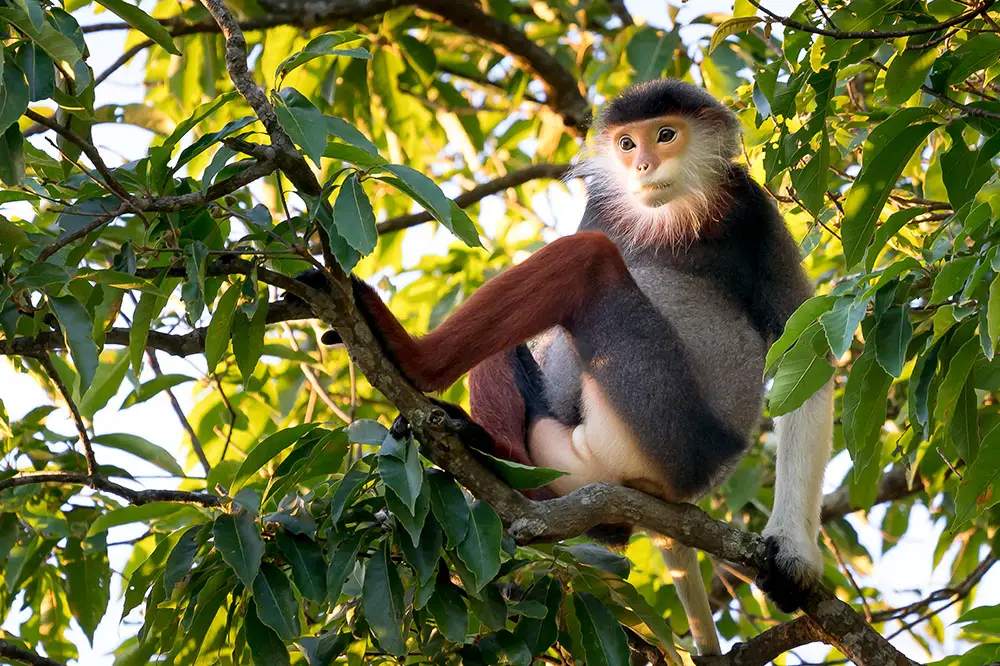

Left: The brightly coloured red-shanked douc & Right: Hanuman langur with her cub in India / Shutterstock (both photos)
Contents
- Dusky Langur | Trachypithecus obscurus
- Javan Langur | Trachypithecus auratus/mauritius
- Gee’s golden langur | Trachypithecus geei
- Northern plains grey langur | Semnopithecus entellus
- Kashmir grey langur | Semnopithecus ajax
- Nilgiri langur | Semnopithecus johnii
- Golden snub-nosed monkey | Rhinopithecus roxellana
- Black snub-nosed monkey | Rhinopithecus bieti
- Red-shanked douc | Pygathrix nemaeus
- Proboscis Monkey | Nasalis larvatus
- Celebes crested macaque | Macaca nigra
- Japanese macaque | Macaca fuscata
- Lion-tailed macaque | Macaca silenus
Dusky Langur | Trachypithecus obscurus
The dusky langur, also known as the spectacled langur, is one of Asia’s smaller species, weighing no more than 20 lb (9 kg / 19.8 lb) and is part of a genus, which I refer to as the golden baby genus. Adults are mostly dark in colour with white rings around the eyes and mouth and lighter hair on the limbs, underside and tail. Their infants, on the other hand, who are born after a gestation period of just under 5 months, have light faces and exhibit golden-orange hair, which fades to adult colouration within 6 months. These lovable primates spend their time in medium size groups of up to 20, which usually contain just 1 or 2 adult males. They live in various kinds of tropical forest, high up in the canopy, where, as langurs or leaf monkeys, they feast mainly on leaves, fruit, shoots and other vegetation.


Left: Dusky langur male and female with baby & Right: Dusky langur with golden babies! / Shutterstock (both photos)
Dusky langurs are found on the Kra Isthmus between Malaysia, Thailand and Myanmar.

Javan Langur | Trachypithecus auratus/mauritius
The Javan langur also has golden babies but their most noticeable fur-related characteristic is the variation in adult colouration. Some adults never lose their natal coat, which does change slightly with age but remains a dark orange colour. This species was split geographically by two subspecies but as of 2020, they are now defined as two separate species. The larger eastern population is now referred to as the spangled ebony langur and is the only one of the two species to exhibit this rare colour morph, which itself is only found in a restricted range. Like the dusky langur, these monkeys are diurnal and spend much of the day eating leaves and other vegetation all while avoiding predators like the Javan leopard.
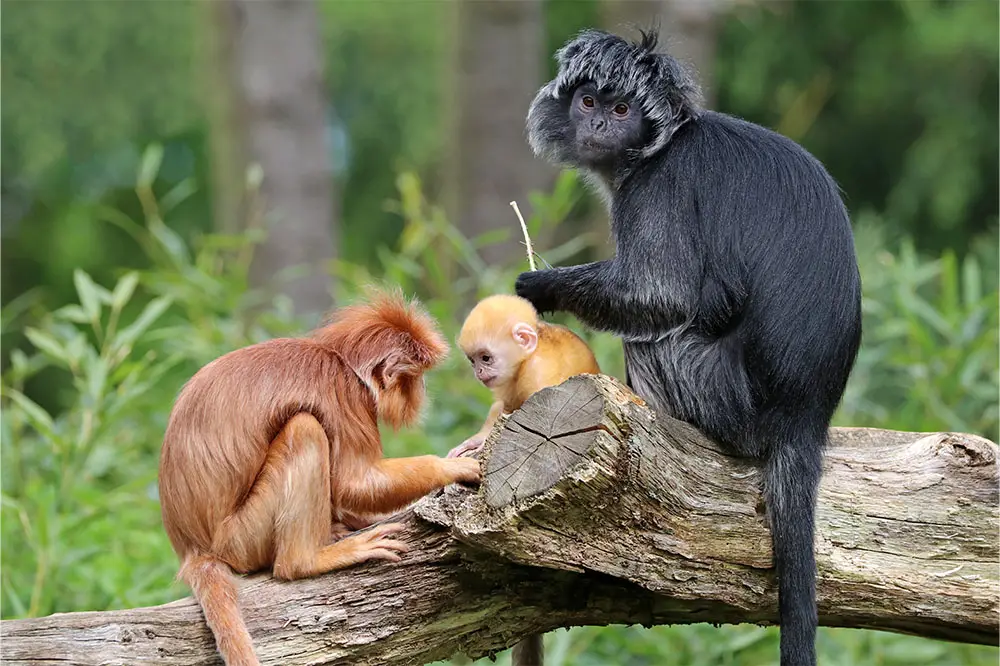

Left: Javan langurs with their golden baby & Right: Javan langurs with normal and orange colour morph / Shutterstock (both photos)
The range of the Javan Langur on the Indonesian islands of Java, Bali and Lombok.

Gee’s golden langur | Trachypithecus geei
Gee’s golden langur also lives high up in the canopy and can be found in various types of tropical and temperate forest as well as at varying elevations. They exhibit a light pelage which contrasts sharply with their dark skin, which is most visible on their face, hands and feet. The coat of juveniles is an even lighter cream colour that darkens to a golden rust with age. While the two previous monkeys are classified as endangered and vulnerable respectively, the golden langur is one of the most endangered species in this video, frequently appearing in The World’s 25 Most Endangered Primates list. They are considered sacred by Himalayan locals and tragically there are estimated to be just 6,000 individuals left in the wild, which are now split between two populations in Bhutan and India. These monkeys weigh up to 24 lbs (10.8 kg) and can be found in groups numbering up to 40 but generally number no more than 8.
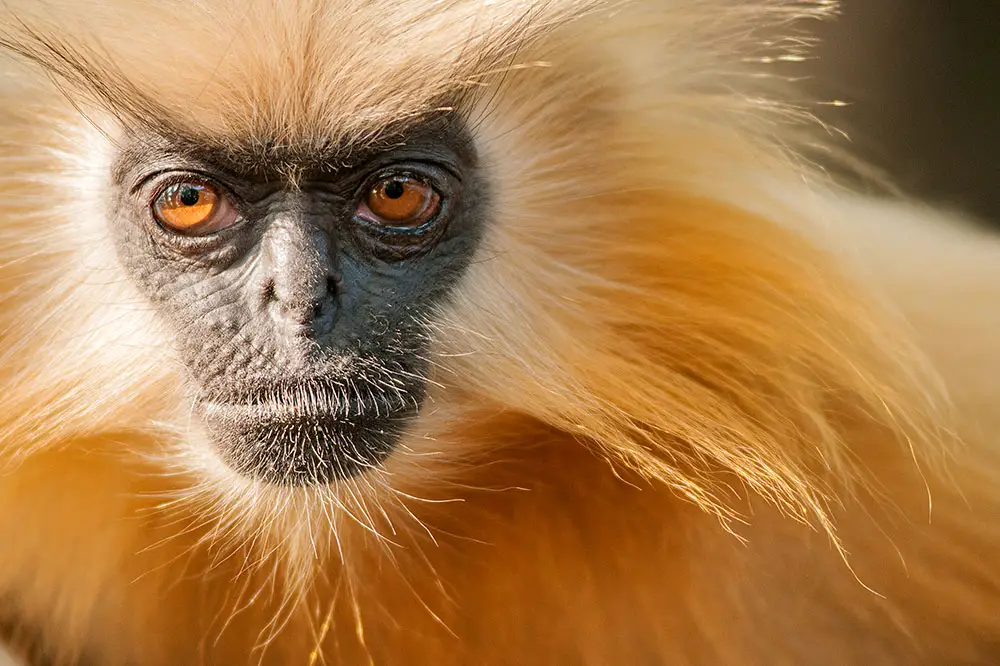
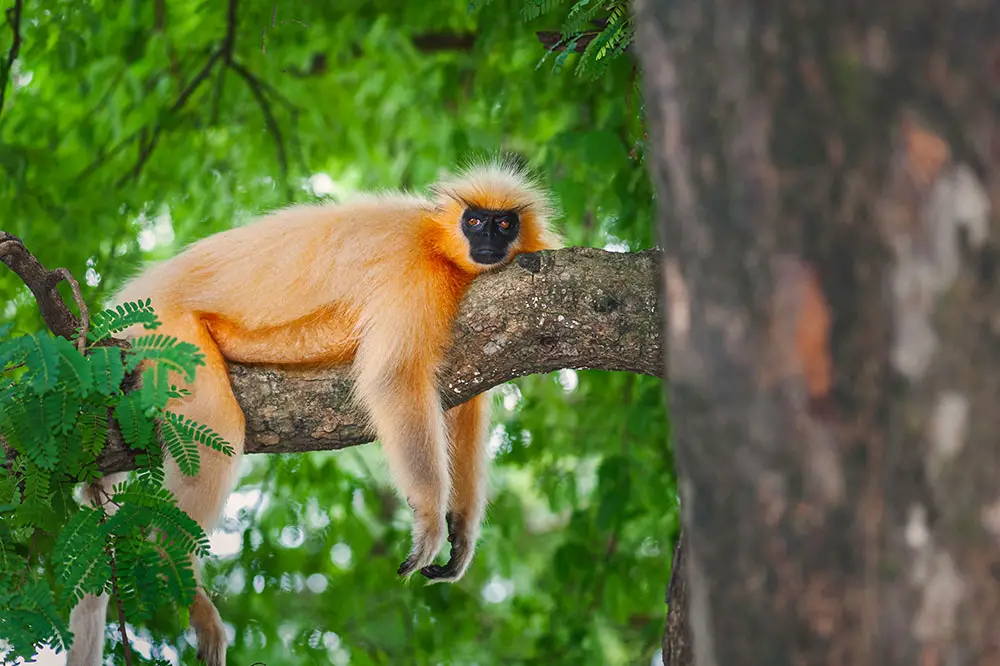
Left: Gee’s golden langur profile & Right: Gee’s Golden langur resting on a tree near Guwahati, Assam, India / Shutterstock (both photos)
The range of Gee’s Golden Langur is found at the foothills of the Himalayas.
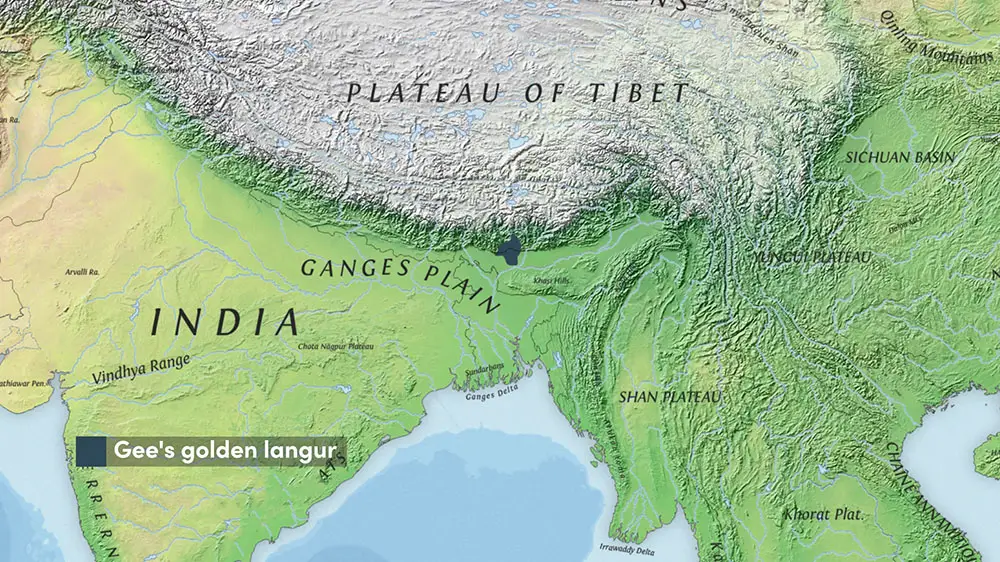
All three of these species are part of the same genus, which is part of a group known as the langur or leaf monkey group. Grey langurs are also part of this group but are quite different in appearance.

Northern plains grey langur | Semnopithecus entellus
The Northern plains grey langur is one of the best examples of this genus and is often referred to as the Hanuman langur. Alarmingly, It is one of only two species in this video with a conservation status of Least Concern. These monkeys are also regarded as sacred, specifically by Hindus, and although they are typically found in the forest, they often live in close proximity to humans, being commonplace in many Indian temples. In contrast to leaf monkeys, these animals are thought of as semi-arboreal, spending 50-80% of their time on the ground. One of their most interesting physical characteristics is their long tails, which at up to 3 ft (102 cm) in length, are even longer than their bodies. Newborns exhibit a natal coat but instead of being brightly coloured it is black and lightens with age. Hanuman langurs live in larger social groups that usually number 20 to 30 but can be as many as 100. Their group structure varies from one-male units to larger multi-male multi-female units and can also be found in exclusively male bachelor groups.
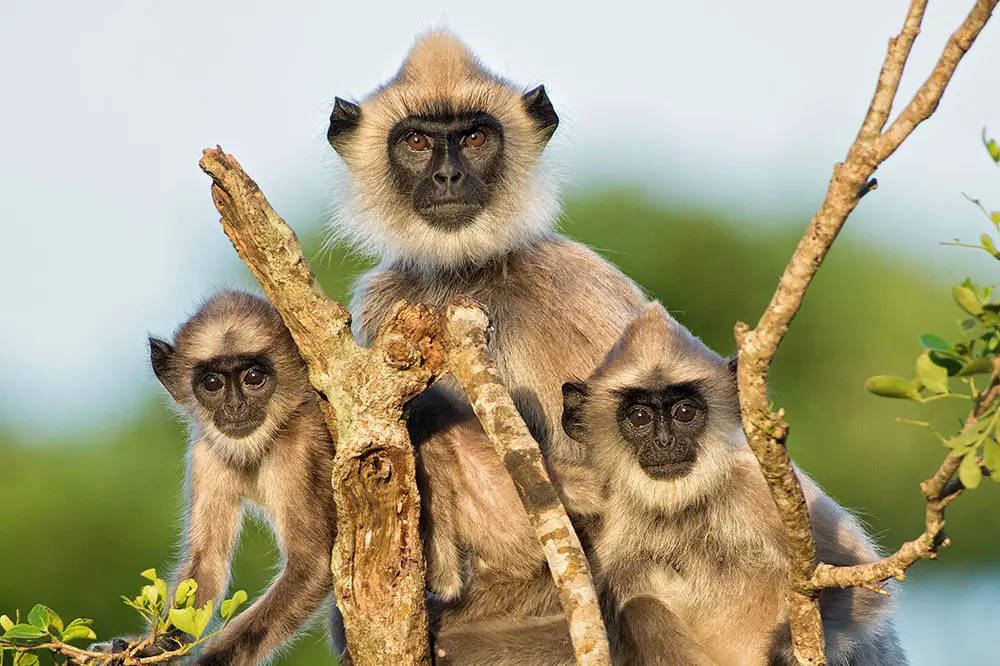
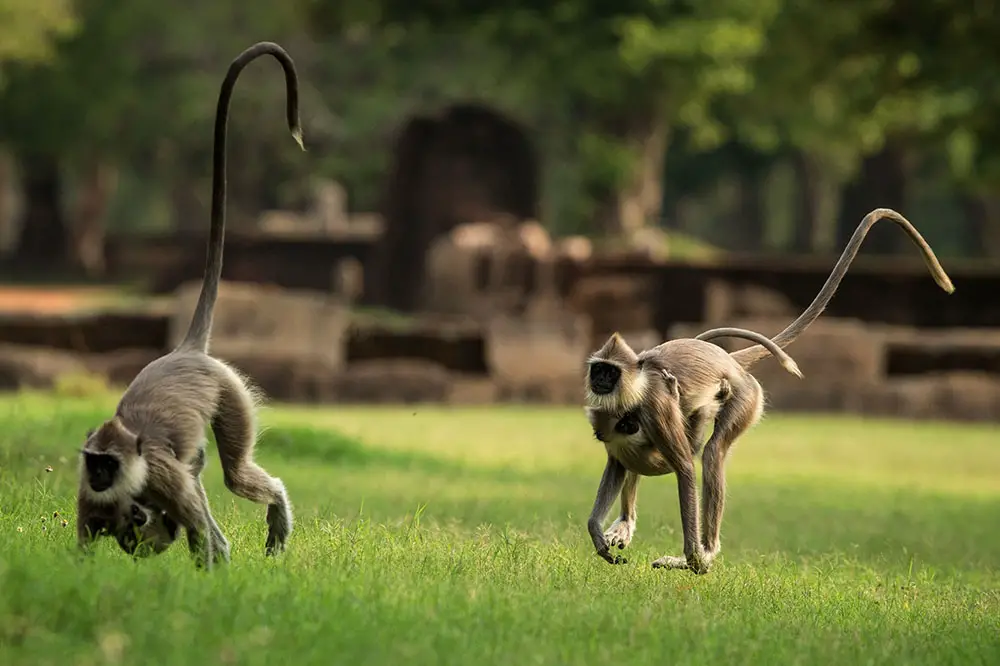
Left: Hanuman langur family & Right: Hanuman langurs with their long tails / Shutterstock (both photos)
These monkeys are found almost entirely in India.
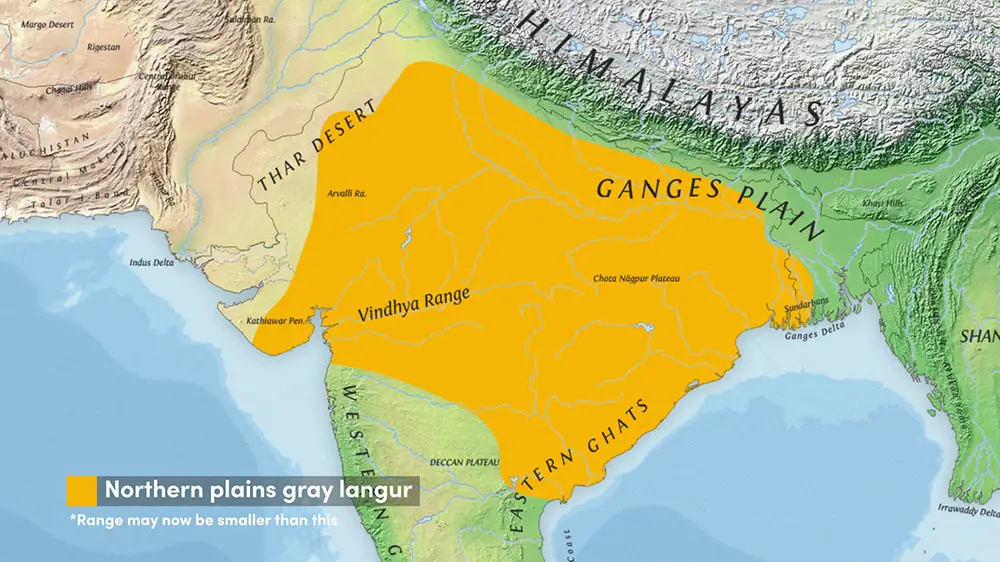
Kashmir grey langur | Semnopithecus ajax
The Kashmir grey langur lives in the foothills of the Himalayas between 6,560 – 13123 ft (2000 – 4000 m). Their fur is much thicker and darker in colour, especially on their arms and legs and they’ve even developed a natural version of the classic parka jacket to stave off the cold. There is some debate as to whether this monkey deserves species status or whether it is just a subspecies of the northern plains grey langur. Regardless, both of these species are on the larger side when it comes to monkeys, with the burliest males topping out just under 40 lbs (17.7 kg / 39 lbs).

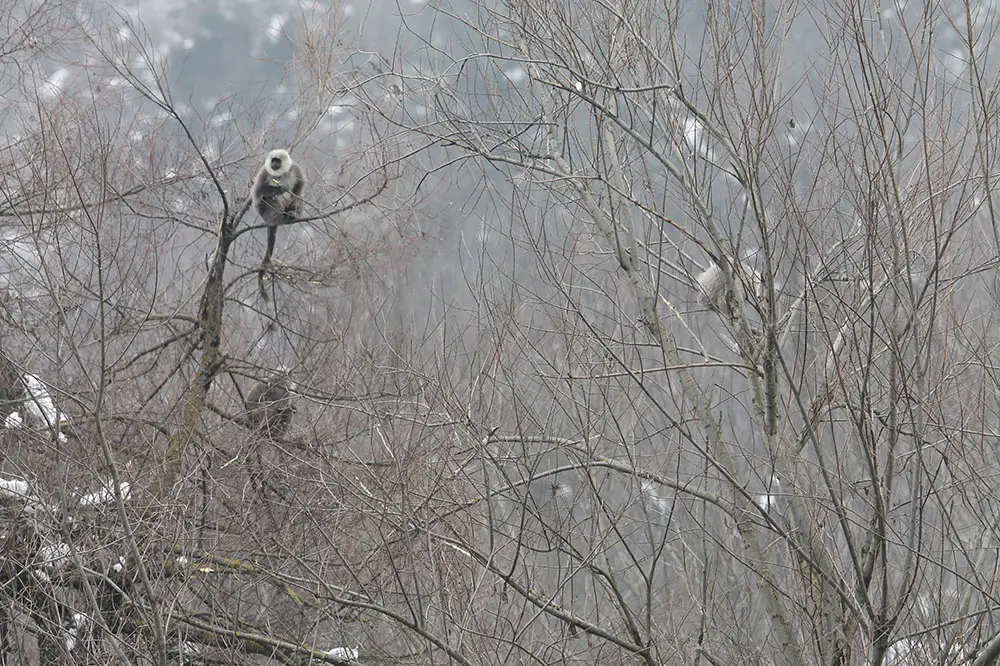
Left: Himalayan grey langur perched in a snowy tree & Right: Himalayan grey langur foraging in the snow / Shutterstock (both photos)
Like the Gee’s golden langur, the range of the Kashmir langur is found in the Himalayas but much closer to Pakistan.

Nilgiri langur | Semnopithecus johnii
The Nilgiri langur, also known as the Indian hooded leaf monkey, has wonderful jet black fur, with matching black skin and one of the most unique hairstyles on this list with a grey, often golden-looking hood of hair around the head. Like the rest of their genus, they exhibit almost unbelievably long tails that exceed the length of their bodies. Their group structure is most commonly a one-male unit averaging between 10-15 members, however, they can also be found in multi-male multi-female units numbering up to 27 individuals. The majority of their diet is made up of leaves, which they spend up to half of their day gathering and have only one known predator, the Indian wild dog also known as the Dhole.


Left: Beautiful Nilgiri Langur & Right: Nilgiri Langur with long tail / Shutterstock (both photos)
The Nilgiri langur is found at the very southern tip of India in the Nilgiri Hills, after which it is named.

All of the species mentioned so far are part of the Langur group, which is one of three groups within the Colobinae subfamily. There is one other located in Asia, which contains monkeys with odd noses.

Golden snub-nosed monkey | Rhinopithecus roxellana
The golden snub-nosed monkey is another primate well-equipped for cooler temperatures, being found in temperate forests at elevations between 4,000 – 13,000 ft (1,200 – 4,000 m). They have thick eye-catching multi-coloured fur, which varies from a deep golden colour to areas of black and a lighter cream. One of their most interesting features is the variation in skin colour. The skin around the eyes is blue and transitions to a lighter shade around the muzzle. The scrotum of males is also blue whereas other areas of skin including the hands, feet and penis are black. Males are particularly large, weighing almost 45 lbs (19.9 kg / 44 lbs) and develop growths at the side of their mouths as they mature. Group structure is complex and varies by season; In summer, they congregate in bands of up to 600 monkeys but diverge into smaller units in the winter, which can number anywhere from 10 to 70 individuals.


Left: Golden Snub-nosed Monkeys & Right: Male Golden Snub-nosed Monkey / Shutterstock (both photos)
Golden snub-nosed monkeys are found in central China on and to the east of the Tibetan plateau.
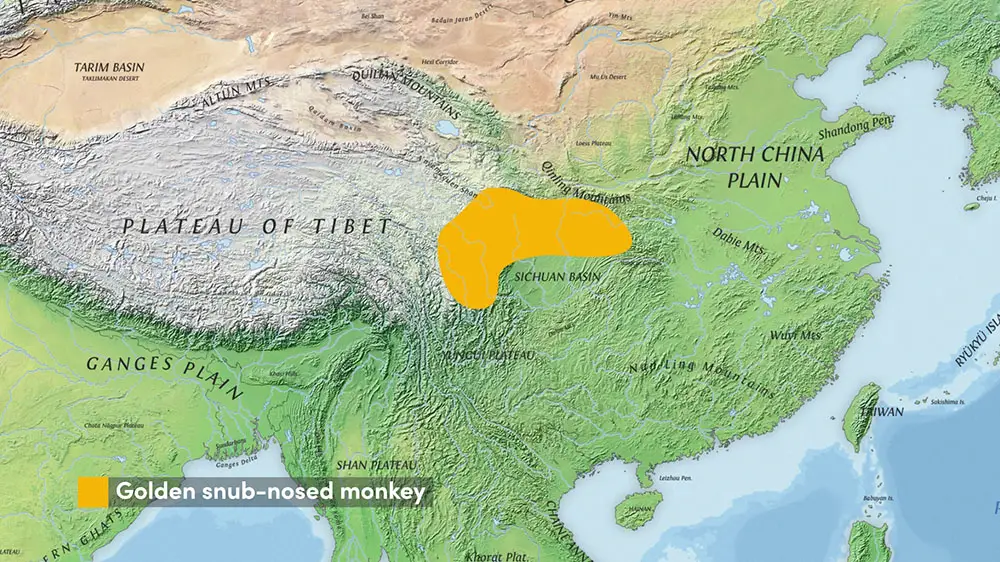
Black snub-nosed monkey | Rhinopithecus bieti
The black snub-nosed monkey, also known as the Yunnan snub-nosed monkey, lives at slightly higher elevations, usually venturing no lower than 9,800 ft (3,000 m). They are mostly found in cool coniferous forests, where temperatures drop below freezing in the winter. Their diet varies by season, eating leaves when available, fruit in the summer, and lichen in the winter. Group structure is very similar to their golden cousins and although still large for monkeys, they are a little smaller, weighing no more than 37.5 lbs (17 kg) and the face is much lighter with lips that are pink in colour. Infants are born with a light coat that darkens in certain areas with age and will cling to their mother’s chest while she searches for food and moves around the canopy. Both of these species are endangered with the number of mature black snub-nosed monkeys down to just 1,000-2,000 individuals.


Left: Yunnan Black Snub-Nosed Monkey & Right: Young Yunnan Black Snub-Nosed Monkey / Shutterstock (both photos)
The range of the black snub-nosed monkey is found to the southwest of their golden cousins.
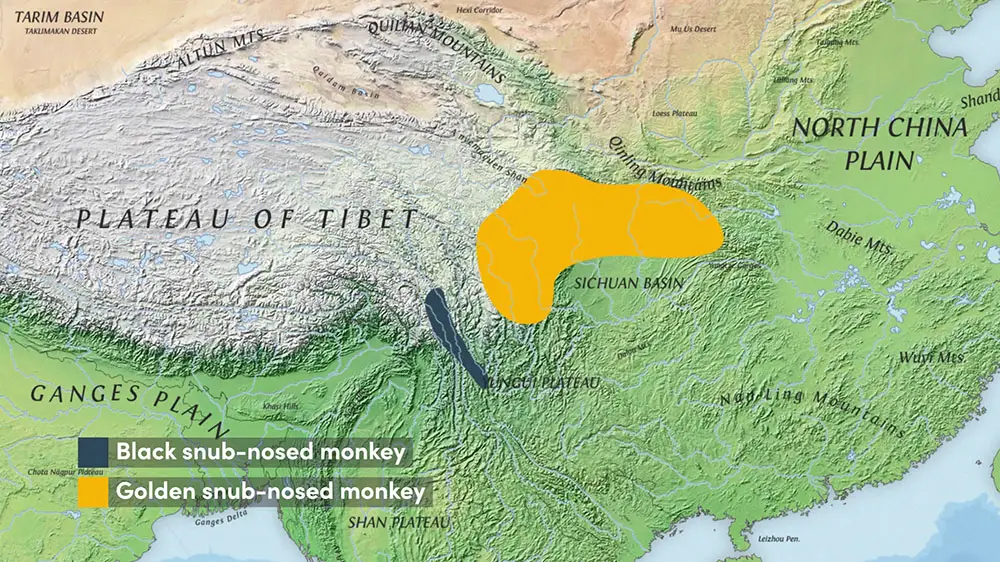
The first of two hops southeast takes us into Southeast Asia to visit another odd-nosed monkey from a different genus.
Red-shanked douc | Pygathrix nemaeus
In a video based on colourful stylish primates, the red-shanked douc exhibits perhaps the most incredible pelage of any monkey on this list. The dark areas on the upper portions of their limbs transition to lighter areas with bands of white on each individual hair producing a natural gradient. The area from the knee to the ankle, referred to as the shank, is a regal reddish-brown, which is also present in a necklace-like ring on the upper torso. The skin of the face is a vibrant orange colour with a lighter muzzle, whereas the hands and feet are black. These slender primates are much smaller than snub-nosed monkeys, with the largest males weighing just under 30 lbs (12.6 kg / 28 lbs). Group size is also smaller, usually numbering around 10-15 members and can contain multiple males. Larger groups can number up to 50 but are much less common. They are found in tropical forests where leaves can make up to 80% of their diet and, sadly, are critically endangered.


Left: Red shanked douc family & Right: The colourful red-shanked douc / Shutterstock (both photos)
The range of the Red-shanked Douc is located on mainland Southeast Asia.
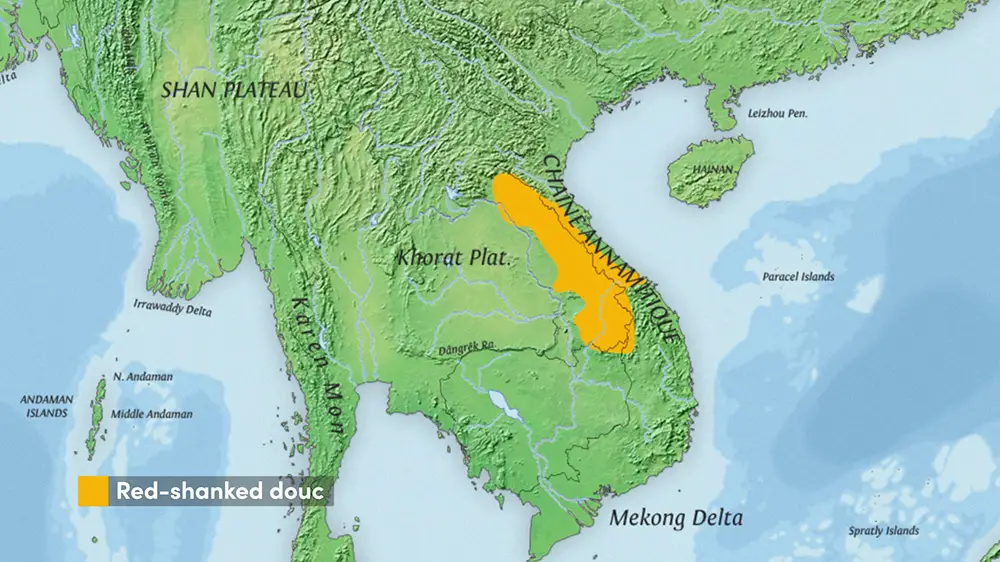
Heading southeast once again, the island of Borneo plays host to the last odd-nosed member we’ll discuss and has arguably the oddest nose of any monkey.
Proboscis Monkey | Nasalis larvatus
The proboscis monkey is one of the largest species of monkey, with the stockiest males weighing close to 50 lbs (22 kg / 48.5 lbs) and females around half. This weight, however, does not make them less agile as they can often be seen skillfully hurling themselves through the canopy of the tropical mangrove forests they inhabit. Although they are also quite stylish, with deep orange fur on their head and torso that transitions to grey on their limbs and tail, their enormous nose—or proboscis—is by far their most defining physical characteristic. The nose of males is much larger than that of females and is used both for making loud vocalisations and as part of their sexual display to females. Although I couldn’t find any supporting photos, another defining characteristic of this species is their ability and tendency to swim. They are rarely found far from water and have webbing between some of their digits to assist with swimming.

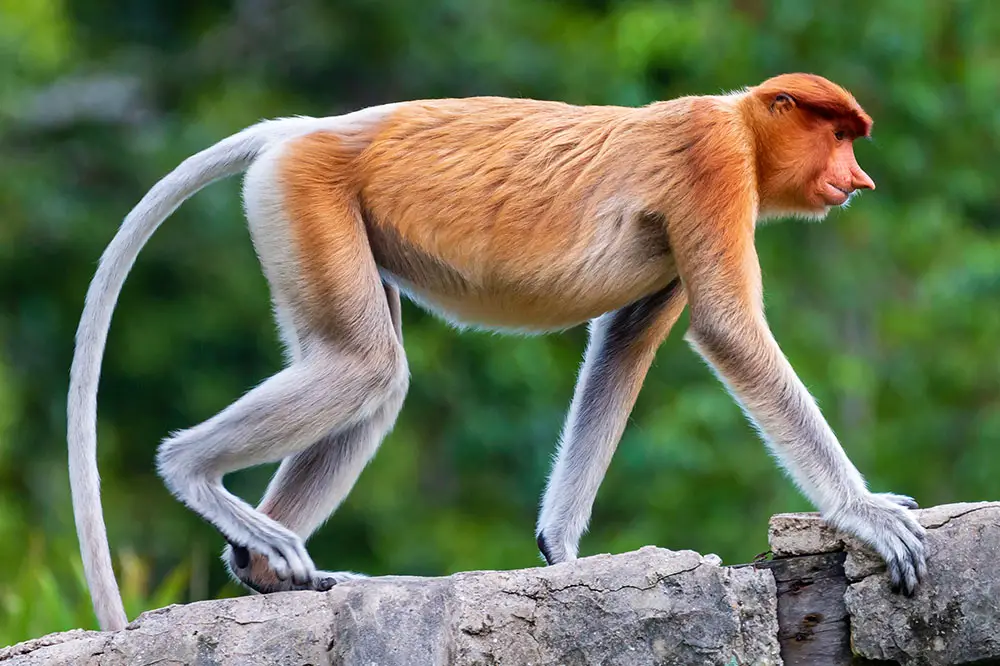
Left: Male and female proboscis monkey & Right: The incredible pelage of the proboscis monkey / Shutterstock (both photos)
The Proboscis monkey is found only on the island of Borneo.

All of the species mentioned so far are contained within the same subfamily, Colobinae. The other side of this family lives mainly in Africa, with the exception of all but one species of macaque.
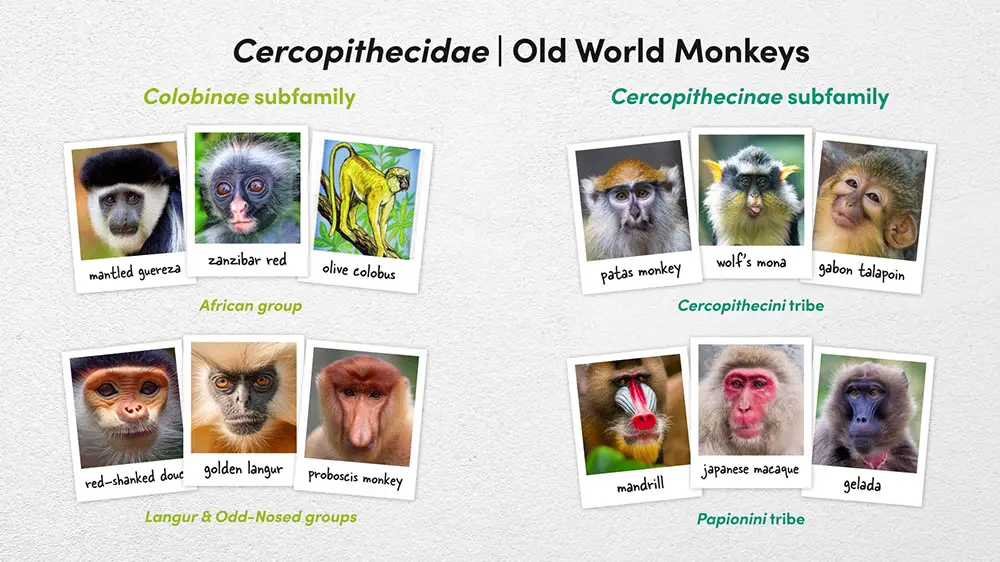
Celebes crested macaque | Macaca nigra
The Celebes crested macaque is the first species we’ll discuss and is one of just a few macaques that exhibit an entirely black coat. They are often referred to as the crested black macaque, referencing the mohawk-like crest of hair on the tops of their heads and also have a somewhat creepy smile. All Old World monkeys have sitting pads or ischial callosities but in all of the species discussed so far, they are difficult to see. This is not the case for Celebes macaques who have bright red skin around theirs and exhibit a stub rather than a tail. This species lives in multi-male multi-female units, usually numbering no more than 25 but can reach as many as 75. At no more than 23 lbs (10.4 kg), they are one of the smaller monkeys on this list.

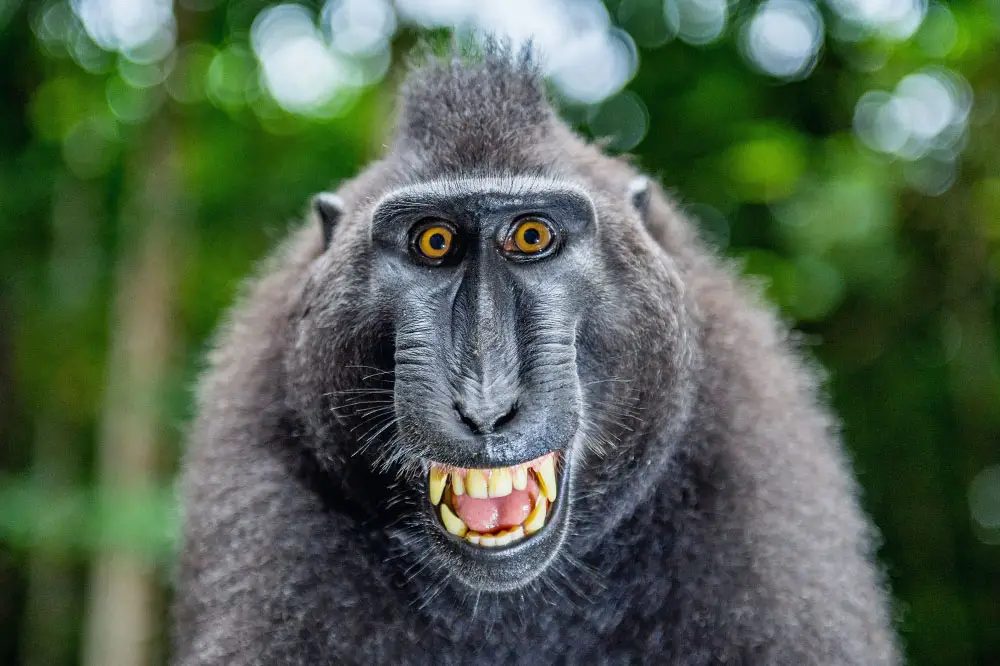
Left: Celebes crested macaque with visible ischial callosities & Right: Crested black macaque with a creepy smile / Shutterstock (both photos)
These monkeys are located on the north-easternmost tip of Sulawesi—also known as Celebes—and on two smaller neighbouring islands.
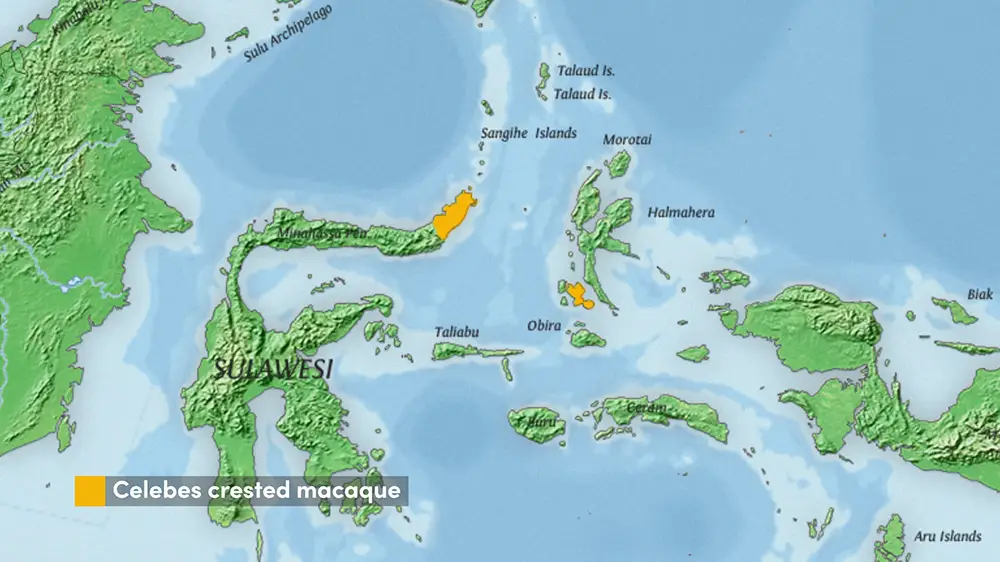
To view our next macaque, we need to travel due north to the island nation of Japan.
Japanese macaque | Macaca fuscata
The Japanese macaque may not be one of the most visually impressive species in Asia but the setting some of these monkeys are found in is the definition of spectacular. Also referred to as snow monkeys, these macaques have the most northerly range of any non-human primate and at the northernmost tip of that range have developed a strategy of relaxing in Japanese hot springs, known as onsens, to handle the frigid Japanese winters. Not all of their time is spent in the water, however; these monkeys spend time both on the ground and in the trees, which is where they sleep at night. Troop size is usually 20-30 individuals but can be much larger and, with males leaving the troop upon puberty, the core of the group is matrilineal. These monkeys are omnivores and in addition to eating leaves and other vegetation will also snack on eggs and various types of invertebrates. Japanese macaques have a few known predators including the cheeky raccoon dog aka the tanuki and the mountain hawk-eagle.


Left: A group of Japanese macaques taking a bath in a hot spring & Right: Mother Japanese macaque carrying baby / Shutterstock (both photos)
The Japanese Macaque is located on several islands in Japan.
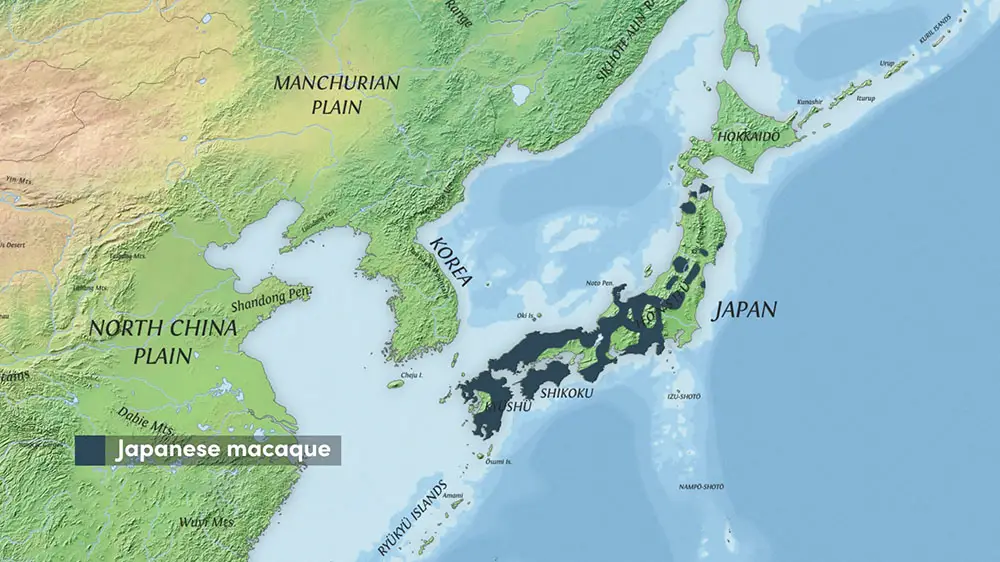
There is one more species of macaque to discuss that is not only found in a very similar range to the Nilgiri langur of Southern India but is also locked in a fierce battle for the best haircut.
Lion-tailed macaque | Macaca silenus
The Lion-tailed macaque resides in various types of tropical forest where it is found high up in the canopy. This species is named so for both its thick lion-like mane but also the lion-like tuft at the end of its long tail, which is not present in many macaque species. The ischial callosities are also clearly visible in this species. Newborns have light skin, which darkens with age and as you might expect are not born with such a magnificent head of hair, which is more magnificent in some individuals than it is in others.
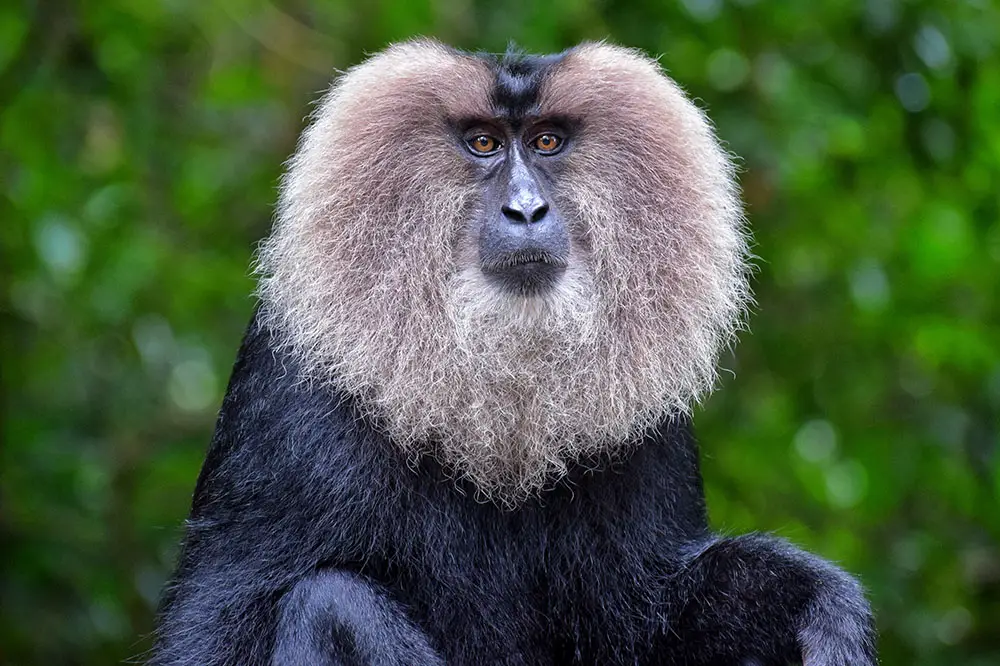
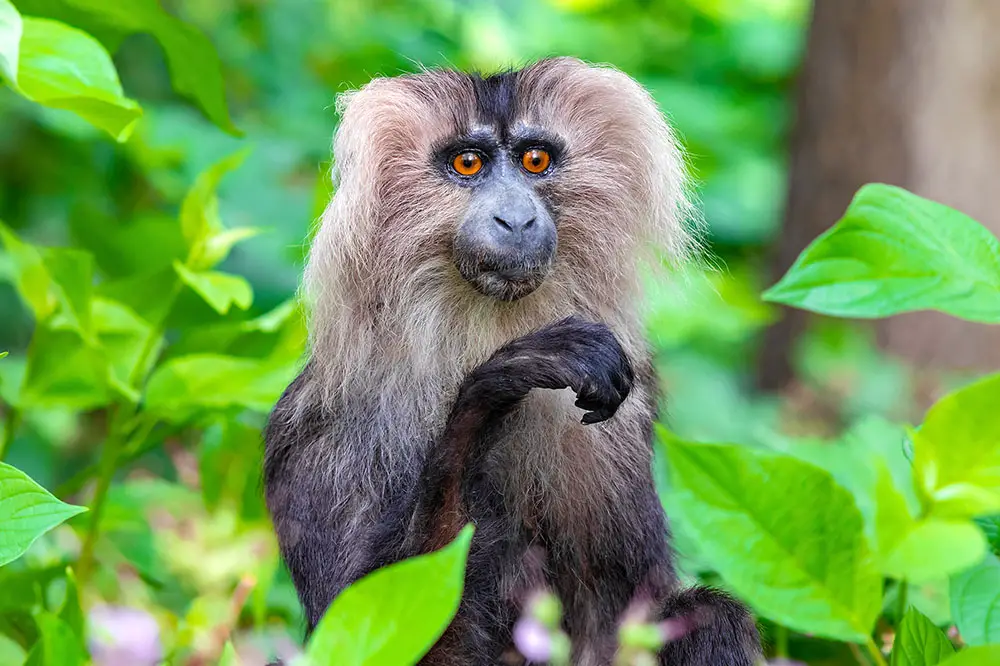
Left: A Magnificent lion-tailed macaque & Right: Funny not-so magnificent lion-tailed macaque / Shutterstock (both photos)
The range of the lion-tailed macaque is very similar to that of the Nilgiri langur.

Sources
New England Primate Conservancy, Animal Diversity, Wisconsin National Primate Research Center, Encyclopaedia Britannica, IUCN Red List, Wikipedia, Dusky leaf monkey, Dusky langur, Gee’s golden langur, Kashmir grey langur, Kashmir langur, Nilgiri langur, Golden snub-nosed monkey & Proboscis Monkey.
